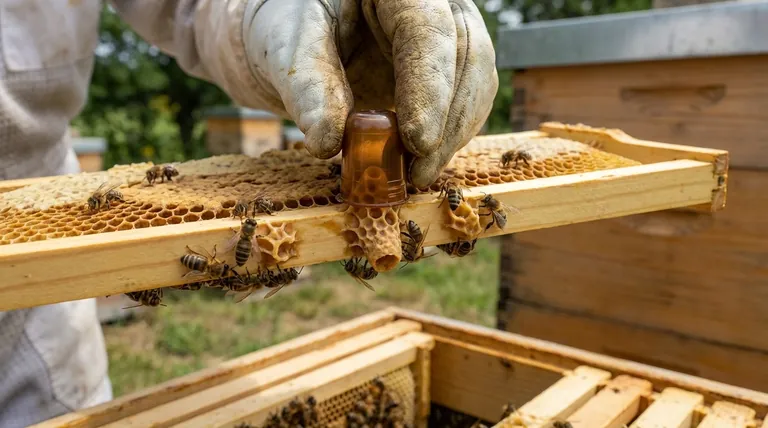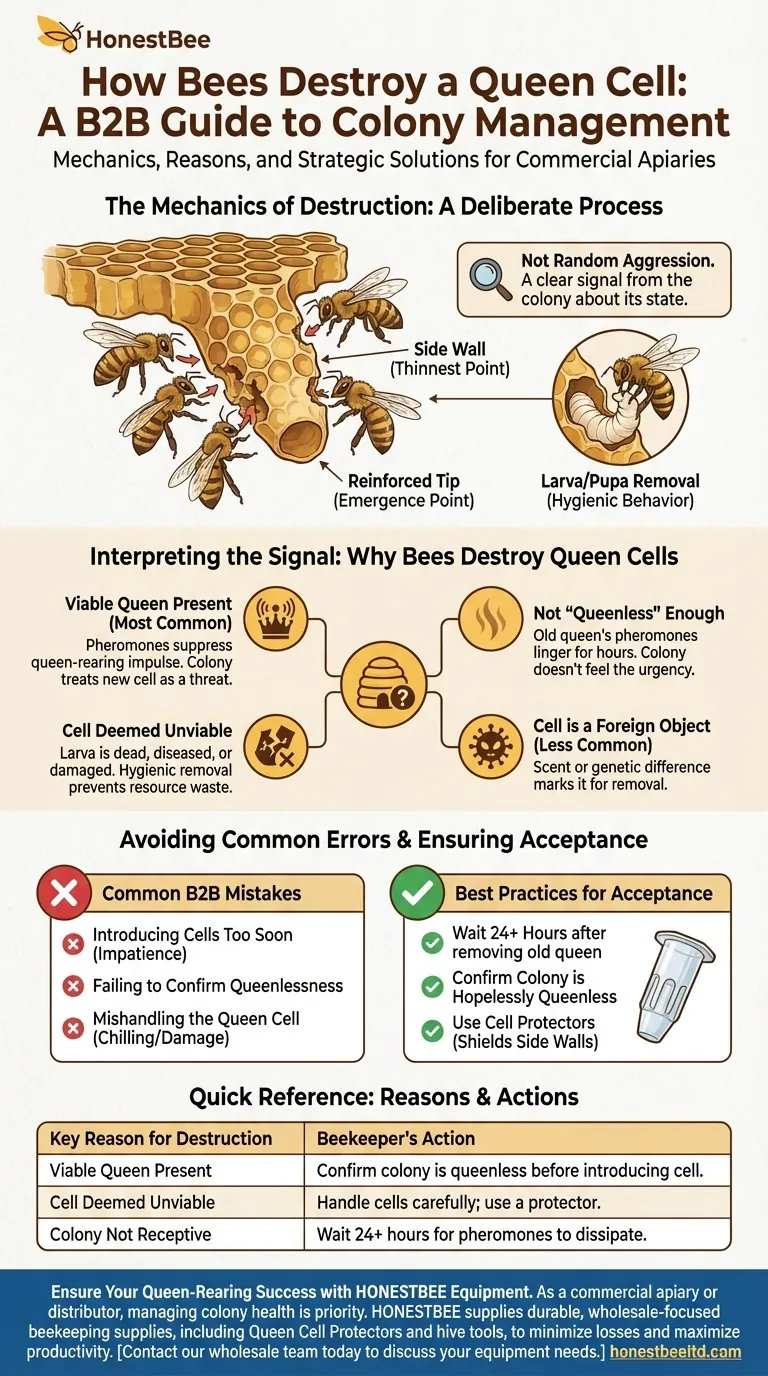Worker bees destroy a queen cell by methodically chewing through its side wall, not the tip. Once they breach the wax and the inner cocoon, they remove the developing queen larva or pupa, effectively terminating its development.
The destruction of a queen cell is not a random act of aggression; it is a clear signal from the colony about its current state. Understanding this behavior is crucial, as it almost always indicates the presence of a satisfactory queen or the perceived unsuitability of the cell itself.

The Mechanics of Destruction: A Deliberate Process
The way bees dismantle a queen cell is highly specific and reveals the efficiency of their instincts. It is a coordinated effort, not a chaotic attack.
Targeting the Side Wall
The primary attack vector is the side of the cell. Multiple worker bees will gnaw at the wax in a concentrated area until they create an opening.
Why the Side? The Path of Least Resistance
A queen cell's construction is not uniform. The tip of the cell, where the virgin queen will eventually emerge, is reinforced, but the base is even tougher due to a thicker accumulation of the pupal cocoon. The side walls present the thinnest and most vulnerable point, requiring the least effort to penetrate.
Removal of the Occupant
Once the cell is breached, the bees will either kill the developing queen within or pull her out of the cell. This hygienic behavior removes the potential rival and cleans the area.
Interpreting the Signal: Why Bees Destroy Queen Cells
The destruction of a queen cell is a form of communication. The colony is telling you something important about its internal status.
A Viable Queen is Present
This is the most common reason. If a colony is queenright—meaning it has a healthy, laying queen—her pheromones suppress the queen-rearing impulse. The workers will treat any introduced or emergency queen cell as an unnecessary threat and systematically eliminate it.
The Colony Is Not "Queenless" Enough
For a colony to accept a new queen cell, it must perceive itself as hopelessly queenless. If you remove a queen, her scent (queen mandibular pheromone) can linger for hours or even days. Introducing a cell too soon will result in its rejection because the workers do not yet feel the urgency of their queenless state.
The Cell is Deemed Unviable
Bees have an incredible ability to detect problems. They may destroy a cell if the larva inside is dead, diseased, damaged, or otherwise non-viable. This is a critical hygienic function that prevents the colony from wasting resources on a flawed queen.
The Cell is a Foreign Object
While less common, a colony may sometimes reject a healthy cell from a different hive. The subtle differences in scent and genetics can mark it for removal, especially in less-receptive colonies.
Understanding the Trade-offs and Common Errors
A beekeeper's success in queen rearing or re-queening often hinges on avoiding a few critical mistakes that lead to cell destruction.
Mistake 1: Introducing Cells Too Soon
The most frequent error is impatience. After removing a queen, you must wait until the colony's "social mood" shifts. This waiting period, typically 24 hours, allows the existing queen's pheromones to dissipate, making the colony receptive to a solution for their queenlessness.
Mistake 2: Failing to Confirm Queenlessness
Never introduce a queen cell without being absolutely certain the colony is queenless. A hidden virgin queen or a failing but still present queen is enough to guarantee the destruction of your new cell.
Mistake 3: Mishandling the Queen Cell
Queen cells are extremely fragile. A chilled, shaken, or damaged cell can injure or kill the pupa inside. The bees will detect this and will promptly dismantle the non-viable cell.
How to Ensure Queen Cell Acceptance
Your approach should be tailored to the specific goal you are trying to achieve with your hive.
- If your primary focus is re-queening an existing colony: Confirm the hive is queenless and wait at least 24 hours after removing the old queen before introducing the new cell.
- If your primary focus is making a split or nuc: Ensure the new colony is hopelessly queenless and has enough nurse bees to care for the cell and the eventual virgin queen.
- If your primary focus is using purchased cells: Introduce them quickly to prevent chilling and consider using a queen cell protector, which shields the cell from the side walls while leaving the tip exposed for the queen to emerge.
Understanding that bees destroy queen cells as a logical response to their environment transforms you from a spectator into an informed manager of your colony's future.
Summary Table:
| Key Reason for Destruction | Beekeeper's Action |
|---|---|
| A Viable Queen is Present | Confirm the colony is queenless before introducing a new cell. |
| The Cell is Deemed Unviable | Handle cells carefully to avoid damage; use a protector. |
| Colony is Not Receptive | Wait 24+ hours after removing the old queen for pheromones to dissipate. |
Ensure your queen-rearing efforts succeed with the right equipment from HONESTBEE.
As a commercial apiary or beekeeping equipment distributor, managing colony health is your top priority. The deliberate destruction of a queen cell by your bees is a clear signal that requires a strategic response and the right tools.
HONESTBEE supplies the durable, wholesale-focused beekeeping supplies you need to manage your colonies effectively, from queen cell protectors to essential hive management tools. Let us help you minimize losses and maximize your apiary's productivity.
Contact our wholesale team today to discuss your equipment needs and keep your colonies thriving.
Visual Guide

Related Products
- Brown Nicot Queen Cell Cups for Breeding Queen Bees Beekeeping
- JZBZ Push-In Queen Cell Cups for Beekeeping
- Clear Black Plain Polystyrene Queen Bee Grafting Cell Cups No Lug for Bee Queen Cup
- JZBZ Langstroth Queen Rearing Frame for Beekeeping
- Professional Queen Catcher and Introduction Queen Cage
People Also Ask
- What should be done with extra queens from grafting? A Strategic Guide for Apiary Management
- What role does the natural swarming process play in queen rearing? Harness the Swarm Instinct for Better Queens
- How many cells are given to a nucleus? Understand the One-to-One Rule in Cell Biology
- What are the signs that a queen cell is about to emerge? Master the Critical Timing for Hive Success
- What is the advantage of the Nicot Cupkit system? Secure Your Queen Rearing Success with Batch Protection













